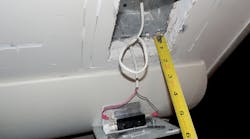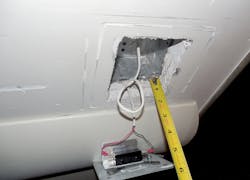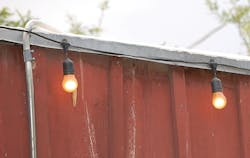How well do you know the Code? Think you can spot violations the original installer either ignored or couldn’t identify? Here’s your chance to moonlight as an electrical inspector and second-guess someone else’s work from the safety of your living room or office. Can you identify the specific Code violation(s) in this photo? Note: Submitted comments must include specific references from the 2017 NEC.
Hint: Measure twice, cut once.
November Winners
Our three winners this month were: Ed Walter, owner and operator of Trinity Valley Machine, Aubrey, Texas; William Simmons, an EC&M reader from Warsaw, Mo; and Thomas Kule, who works for Simplex Homes in Scranton, Pa. They all knew the set-screw type of coupling used on this outdoor run of electrical metallic tubing (EMT) could create some real problems with moisture infiltration.
Section 358.42 requires EMT couplings and connectors installed in wet locations to meet the requirements of Sec. 314.15. In that section of the NEC, we learn that boxes, conduit bodies and fittings like couplings and connectors installed in wet locations must be specifically listed for use in wet locations. In this case, a compression type of coupling would have been a much better choice. The way the coupling is presently installed could allow rain and moisture to easily enter and follow the raceway all the way to where the wires are terminated. Wet splices or terminals could cause equipment damage, and create a real shock or fire hazard. Section 225.22 requires raceways installed on the exterior of a building to be arranged to drain any moisture or water. This one seems arranged to accumulate moisture and water.
One reader also pointed out that Sec. 590.4(F) would require installation of some type of protective guard for the lamps if these lampholders were installed for temporary lighting purposes.






